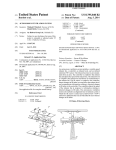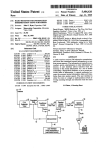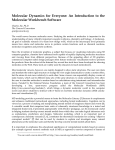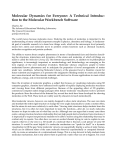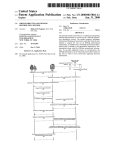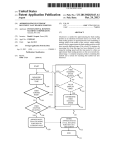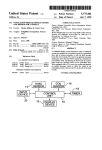Download Vehicle air conditioner and vehicle ventilation system
Transcript
US006949021B2 (12) United States Patent (10) Patent N0.: Ichishi et al. (54) US 6,949,021 B2 (45) Date of Patent: VEHICLE AIR CONDITIONER AND 6,659,358 B2 * 12/2003 Kamiya et al. .......... .. 236/49.3 VEHICLE VENTILATION SYSTEM 6,698,262 B2 * 3/2004 Wittwer .......... .. 2001/0039806 A1 * 11/2001 IIIVCIIIOI‘SZ Kumada, YOShIIlOI‘I Gamagor1 IChIShI, I<ariya (JP) Notice: 70/208 Kawai et al. ............... .. 62/229 Tatsumi (73) Assignee: Denso Corporation, Kariya (JP) (*) Sep. 27, 2005 Subject to any disclaimer, the term of this patent is extended or adjusted under 35 U.S.C. 154(b) by 0 days. JP 01167551 A * JP 5493349 * 8/1993 7/1989 JP 10-278564 * 10/1998 JP JP 2000442089 2002264635 * 5/2000 9/2002 .......... .. F24F/11/02 * cited by examiner _ Primary Examiner—Harold Joyce (21) Appl' NO" 10/779’574 (74) Attorney, Agent, or Firm—Harness, Dickey & Pierce, (22) Filed: Feb. 13, 2004 PLC (65) Prior Publication Data (57) Us 2004/0185764181 56p 23’ 2004 _ (30) _ _ _ _ sensor is used as an inside Forelgn Apphcatlon Pnonty Data Feb. 24, 2003 ABSTRACT In a vehicle air conditioner, a non-contact temperature air temperature sensor for detecting a temperature in a passenger compartment. Based (JP) ..................................... .. 2003-046124 7 on infrared rays radiated from a predetermined area of the passenger compartment, the non-contact temperature sensor (51) Int- Cl- (52) US. Cl. ......................... .. 454/75; 62/186; 165/288; ..... - - - - - - - - - - - - - - - - - - - - - - - -- B6011 1/00 58 F'1e ld 0 f S earc h ........................ .. 4 5 4/7 5,- 236/91 E , 236/49.3 236/51, 49.3; 62/186; 165/202, 288, 291 detects a surface temperature in the predetermined area in non-contact. Therefore, it is not necessary to bloW air from the passenger compartment to the inside air temperature sensor 1n ' or d er to d etect t h e tem p erature 1n ' t h e p assen g er compartment. Thus, energy consumption can be reduced While the temperature in the passenger compartment can be (56) References Cited accurately detected. Accordingly, While the vehicle stops, U'S' PATENT DOCUMENTS the vehlcle a1~r cond1t1oner can accurately determme Whether 6,202,934 B1 * 6,397,615 B1 * 6,550,686 B2 * an cond1t1omng control by an a1r cond1t1onmg umt needs be 3/2001 Kamiya et al. ......... .. 236/91 (3 6/2002 Kawai et al. 4/2003 Kawai et a1. ............ .. 236/493 started While energy consumption can be reduced. 20 Claims, 7 Drawing Sheets START (16 OFF) S100 DISTANCE<D1? YES 8110 F(t)>F(1;-5)? YES 5120 BATTERY VOLTAGE>12V? S130 YES DETECT TEMPERATURE T(R1) IN AREA R1 S140 S150 SET “STRONG”? S160 <=ATTERY VOLTAGE>11.5V" YES S170 PERFORM FULL AIR-CONDITIONING OPERATION FOR A PERIOD (1MIN) (CALCULATE TAO(Dr) AND TAO(Pa)) | YES 8162 ERFORM VENTILATI (IN PERATION FOR A P ERIOI) (1MIN) U.S. Patent Sep. 27,2005 Sheet 1 0f 7 US 6,949,021 B2 3A5l8Em 2 w w _ u 59 W1L _5AWE, my? ,:x22 ,$2, 5mo3m\< onSNdim: m?»R 2mI.E,2N“R 6m" " U 53 _2. 1 g em m A \ N mm mmE5 :_ ___ -a) n _ i“ Aliwee:__H? ON\Sr m08 .qm0?" N“; \_ omr_ H. w? n wsw n_ P.UE@05 0 U.S. Patent Sep. 27,2005 Sheet 3 0f 7 FIG. 3 5O 51 FIG. 4 71, 72 21 2O US 6,949,021 B2 U.S. Patent Sep. 27,2005 Sheet 4 0f 7 FIG. 5 R2 US 6,949,021 B2 U.S. Patent Sep. 27,2005 Sheet 5 0f 7 US 6,949,021 B2 FIG. 6 S100 DISTANCE<D1? $110 N0 8120 BATTERY VOLTAGE>12V? DETECT TEMPERATURE T(R1) IN AREA R1 $150 No SET “STRONG”? S151 NO YES S160 ATTERY VOLTAGE>11.5V'7 SET “WEAK”? NO YES/S162 PERFORM VENTILATION YES PERFORM FULL AIR-CONDITIONING OPERATION FOR A PERIOD (1MIN) (CALCULATE TAO(Dr) AND TAO(Pa)) I \ END OPERATION FOR A PERIOD (mm) U.S. Patent Sep. 27, 2005 Sheet 6 0f 7 US 6,949,021 B2 FIG. 7 FIG. 8 5wE<a:s3:0 FIG. 9 (FRS) 100 — sw1 (%) (REC) 0 - TAOe —> HIGH U.S. Patent Sep. 27, 2005 US 6,949,021 B2 Sheet 7 0f 7 FIG. 10 S120 NC) ATTERY VOLTAGE>12.0V? $130Mq DETECT TEMPERATURE TIR(Dr) IN AREA R1 VA 5.0 1*‘ [v] 4.5 4.0 F 34 35 39 40 44 45 TIR(DF) [°C] END US 6,949,021 B2 1 2 VEHICLE AIR CONDITIONER AND VEHICLE VENTILATION SYSTEM compartment is detected. Thus, energy consumption due to air bloWing can be prevented While the temperature in the passenger compartment can be accurately detected. Accordingly, the vehicle ventilation system can accurately determine the timing to start ventilating by the ventilating CROSS REFERENCE TO RELATED APPLICATION unit While energy consumption can be reduced. According to an another aspect of the present invention, This application is base on Japanese Patent Application an air conditioner for a vehicle includes an air conditioning unit Which controls an air condition in a passenger compart ment While the vehicle stops, a non-contact temperature sensor Which detects infrared rays radiated from a predeter mined area of the passenger compartment and detects a No. 2003-46124 ?led on Feb. 24, 2003, the disclosure of Which is incorporated herein by reference. BACKGROUND OF THE INVENTION surface temperature in the predetermined area in non-contact 1. Field of the Invention based on the detected infrared rays, and an air-conditioning The present invention relates to a vehicle air conditioner determining means Which determines Whether an air condi and a vehicle ventilation system, Which are operated While 15 tioning control by the air conditioning unit needs to be a vehicle stops. started based on the surface temperature detected by the non-contact temperature sensor. Therefore, the vehicle air conditioner can accurately determines Whether air condi 2. Description of Related Art An automatic ventilation system for a vehicle, Which is used While the vehicle stops, is proposed in JP-A-2000 tioning control by the air conditioning unit needs to be 142089. In this system, a temperature sensor is used in order to detect a temperature in a passenger compartment. If the started While energy consumption can be reduced. Preferably, the ventilation system further includes a res ervation means Which reserves to perform the ventilation by detected temperature is higher than a predetermined value, a bloWer is automatically operated and ventilates the pas senger compartment. Generally, a dashboard is heated by sunlight entering into the passenger compartment, for example, in the daytime in the ventilating unit in advance. Similarly, the air conditioner 25 includes a reservation means Which reserves to perform the air conditioning by the air conditioning unit in advance. Alternatively, the ventilation system or the air conditioner summer. Thus, if a thermistor inside the dashboard is used as the temperature sensor, the heated dashboard affects a temperature detection of the thermistor because an air tem includes a distance determining means for determining a distance betWeen a user and the vehicle. In this case, the perature inside the dashboard increases. user to the vehicle based on the detected distance betWeen distance determining means determines an approach of the In order to detect a temperature in the passenger com partment correctly, it is possible to bloW air toWard the temperature sensor by a bloWer Whenever the temperature sensor detects a temperature. HoWever, in this case, large energy is consumed because the bloWer is operated. 35 ventilation by the ventilating unit or the air conditioning by the air conditioning unit needs to be started When the distance determining means determines the approach of the Therefore, if the ventilation system ventilates the passenger compartment for a long time While the vehicle stops, all energy of a battery may be spent. user. 40 SUMMARY OF THE INVENTION In vieW of the foregoing problems, it is an object of the present invention to provide a vehicle ventilation system Which reduces energy consumption and accurately deter mines a timing to start ventilating a passenger compartment While a vehicle stops. 45 infrared rays. The ventilation determining means determines Whether a ventilation by the ventilating unit is started based on the surface temperature detected by the non-contact surface temperature in the predetermined area including a seat in the passenger compartment in non-contact. Therefore, the ventilation or the air conditioning can be performed to be ?tted to the thermal feeling of the passenger. According to a further aspect of the present invention, a control system for controlling a vehicle air conditioner or a ventilation system While a vehicle is stopped, includes a determining means that determines Whether an air condi tioning control by an air conditioning unit or a ventilation control by a ventilation unit needs to be started based on a surface temperature detected by a non-contact temperature sensor. Thus, While the vehicle stops, the control system control of a passenger compartment While a vehicle stops. According to an aspect of the present invention, a vehicle ventilation system includes a ventilating unit, a non-contact temperature sensor and a ventilation determining means. While a vehicle stops. The non-contact temperature sensor detects infrared rays radiated from a predetermined area of the passenger compartment in non-contact and determines a surface temperature of the predetermined area based on the More preferably, in the ventilation system or the air conditioner, the non-contact temperature sensor detects a It is another object of the present invention to provide a vehicle air conditioner Which reduces energy consumption and accurately determines a timing to start air conditioning The ventilating unit ventilates a passenger compartment the user and the vehicle When the detected distance betWeen the user and the vehicle is smaller than a predetermined value, and the ventilation determining means or the air conditioning determining means determines Whether the accurately determines a timing to start the air conditioning 55 control or the ventilation control of the passenger compart ment While energy consumption can be effectively reduced. BRIEF DESCRIPTION OF THE DRAWINGS Additional objects and advantages of the present inven tion Will be more readily apparent from the folloWing detailed description of preferred embodiments When taken together With the accompanying draWings, in Which: FIG. 1 is a schematic diagram shoWing an entire system temperature sensor. Because the non-contact temperature of a vehicle air conditioner according to a ?rst embodiment sensor is used in the vehicle ventilation system according to the present invention. Therefore, it is not necessary to bloW 65 of the present invention; FIG. 2 is a front vieW shoWing an air-conditioning opera air from the passenger compartment to the non-contact tion panel in FIG. 1; temperature sensor When a temperature in the passenger US 6,949,021 B2 3 4 FIG. 3 is a front vieW showing an arrangement of inside air temperature sensors in FIG. 1; heat exchanger) 42 is provided in the air duct 2 on a doWnstream air side of the evaporator 41. The heater core 42 FIG. 4 is a perspective vieW shoWing the arrangement of the inside air temperature sensors in FIG. 1; FIG. 5 is a perspective vieW shoWing a detection area of heats air ?oWing therethrough in ?rst and second air pas 5 air passages 11, 12 are separated by a division plate 14. each of the inside air temperature sensors in a passenger Further, a Peltier element can be also used as the evaporator compartment; 41 When the air conditioner is used for a vehicle driven by electric poWer. FIG. 6 is a ?oWchart shoWing an air-conditioning opera tion of an A/C ECU in FIG. 1 in the ?rst embodiment of the A driver-seat side air mixing door (driver-seat side A/M door) 15 and a passenger-seat side air mixing door (passenger-seat side A/M door) 16 are provided on an present invention; FIG. 7 is a characteristic graph for determining bloWer voltage in the ?rst embodiment of the present invention; FIG. 8 is a characteristic graph for determining an air outlet mode in the ?rst embodiment of the present invention; sages 11, 12 by exchanging heat With cooling Water (hot Water) of the engine for driving. Here, the ?rst and second 15 FIG. 9 is a characteristic graph for determining an open ing degree of an inside-outside air sWitching door in the ?rst embodiment of the present invention; and FIG. 10 is a ?oWchart shoWing an air-conditioning opera tion of an A/C ECU according to a second embodiment of upstream air side of the heater core 42. The driver-seat side A/M door 15 independently controls an air temperature to be bloWn into the driver-seat side area of the passenger compartment, and the passenger-seat side A/M door 16 independently controls an air temperature to be bloWn into the passenger-seat side area of the passenger compartment. The driver and passenger-seat side A/M doors 15, 16 are driven by the actuators (e.g., servo motors 17, 18) and control a temperature of conditioned air bloWing from driver the present invention. and passenger-seat side air outlets to the driver and passenger-seat side areas respectively. More particularly, the temperature of conditioned air bloWn toWard inner surfaces DETAILED DESCRIPTION OF THE PRESENTLY PREFERRED EMBODIMENTS 25 Preferred embodiments of the present invention Will be described hereinafter With reference to the accompanying of front Windshield on the driver and passenger-seat sides are respectively controlled. The driver and passenger-seat side air outlets Will be explained beloW. Here, the evaporator 41 according to the ?rst embodiment of the present invention is a part of a refrigerant cycle 400 draWings. (First Embodiment) The ?rst embodiment of the present invention Will be noW described With reference to FIGS. 1—9. In the ?rst embodiment of the present invention, an air cycle 400 includes an electric compressor 410, a condenser conditioner is typically used for performing an air conditioning in a passenger compartment of a hybrid vehicle 420, a gas-liquid separator 430, the above-described expan sion valve 440 and refrigerant piping Which connects the Which has both an engine and an electric motor for driving. The vehicle air conditioner is an automatic air conditioner Which includes an air conditioning unit 1 and an air and evaporates refrigerant Which is decompressed and expanded by an expansion valve 440. Further, the refrigerant 35 ?oWs into the condenser 420 to be lique?ed and condensed. Then, the gas-liquid separator 430 separates the lique?ed conditioning electronic control unit (A/C ECU) 10. The air conditioning unit 1 can independently control an air tem perature in a driver-seat side area (e.g., right side area in a above-described parts circularly. In the refrigerant cycle 400, refrigerant discharged from the electric compressor 410 and condensed refrigerant from the condenser 420 into gas 40 right steering Wheel) and an air temperature in a passenger seat side area (e.g., left side area in the right steering Wheel). Here, in the vehicle having the right steering Wheel, the refrigerant and liquid refrigerant, so that only the liquid refrigerant ?oWs doWnstream. Then, the expansion valve 440 decompresses and expands the liquid refrigerant from the gas-liquid separator 430. In the refrigerant cycle 400, the electric compressor 410 driver-seat side area includes a rear seat on the right side of 45 the vehicle, and the passenger-seat side area includes a rear compresses and discharges refrigerant. The electric com seat on the left side of the vehicle. The air conditioning unit pressor 410 includes an electric motor 460 and an inverter 1 can also independently change an air outlet mode in the 470. The electric motor 460 drives the electric compressor 410. For example, a three-phase induction motor is used as the electric motor 460. The inverter 470, to Which a battery driver-seat side area and the passenger-seat side area. Further, the A/C ECU 10 controls each actuator in the air conditioning unit 1 so as to control air-conditioning opera tion of the air conditioning unit 1. Speci?cally, the air conditioning unit 1 includes an air duct 2 Which is provided on a front side of the passenger compartment. An inside-outside air sWitching door 3 and a 55 bloWer 4 are provided on an upstream air side of the air duct 2. The inside-outside air sWitching door 3 is driven by the actuator (e. g., servo motor 5) and changes an opening degree B supplies electric poWer, changes a rotation speed of the electric motor 460 according to a driving frequency calcu lated by the A/C ECU 10. Accordingly, the electric compressor 410 changes the amount of refrigerant discharged from its discharge port to the condenser 420 by changing a rotation speed of the electric motor 460. Thus, a cooling capacity of the evapo rator 41 can be controlled by controlling the amount of of each of an inside air introduction port 6 and an outside air refrigerant circulated in the refrigerant cycle 400, that is, the introduction port 7. The bloWer 4 is a centrifugal electrical bloWer that is amount of refrigerant ?oWing into the evaporator 41. A driver-seat side defroster air outlet 20, a driver-seat side center-face air outlet 21, a driver-seat side side-face air outlet 22 and a driver-seat side foot air outlet 23 are opened driven and rotated by a bloWer motor 9 controlled by a bloWer driving circuit 8. In the air duct 2, the bloWer 4 generates an air ?oW toWard the passenger compartment. An evaporator (cooling heat exchanger) 41, Which cools air ?oWing through the air duct 2, is provided in the air duct 2 doWnstream of the bloWer 4. Further, a heater core (heating at doWnstream ends of air ducts connected to a doWnstream 65 air side of the ?rst air passage 11 (FIG. 1). Further, a passenger-seat side defroster air outlet 30, a passenger-seat side center-face air outlet 31, a passenger US 6,949,021 B2 5 6 seat side side-face air outlet 32 and a passenger-seat side foot air outlet 33 are opened at downstream ends of air ducts connected to a downstream air side of the second air passage Here, the inside air temperature sensors 71, 72 are arranged integrally in the dashboard 50 as shown in FIGS. 3 and 4. The driver-seat side inside air temperature sensor 71 detects a temperature in an area R1 (FIG. 5) including a seat surface on the driver-seat side in non-contact. Further, the 12 (FIG. 1). Here, the driver and passenger-seat side defroster air outlets 20, 30 are air outlets for blowing conditioned air (mainly, warm air) to the front windshield at the right and left sides. The right and left side side-face air outlets 22, 32 are air outlets for blowing conditioned air (mainly, warm air) to right and left side windowpanes. Then, driver and passenger-seat side air-outlet mode switching doors 24—26, 34—36 are provided in the ?rst and driver-seat side inside air temperature sensor 71 has a sensor element which is arranged so that a light receiving surface points to the area R1. The sensor element of the driver-seat side inside air temperature sensor 71 outputs an electric 10 second air passage 11, 12. The air outlet mode on each of the driver and passenger-seat sides can be set independently by using these doors 24—26, 34—36. Further, these doors 24—26, 34—36 are driven by the actuators (e.g., servo motors 28, 29, 38, 39). Here, the vehicle air conditioner has a face mode, a 15 bi-level mode, a foot mode and a defroster mode, for eXample, as the air outlet mode on the driver-seat side and the air outlet mode on the passenger-seat side. The A/C ECU 10 is supplied with DC power from the battery B and performs some control operation, such as air conditioning control in the passenger compartment while the vehicle drives and air conditioning control in the passenger compartment while the vehicle stops. The control while the vehicle stops will be described below. As shown in FIG. 1, the A/C ECU 10 receives switching signals from operation signal according to a quantity of infrared rays radiated from the area R1. The passenger-seat side inside air temperature sensor 72 detects a temperature in an area R2 (FIG. 5) including a seat surface on the passenger-seat side in non-contact. Further, the passenger-seat side inside air temperature sensor 72 has a sensor element which is arranged so that a light receiving surface points to the area R2. The sensor element of the passenger-seat side inside air temperature sensor 72 outputs an electric signal according to a quantity of infrared rays radiated from the area R2. Here, each of the inside air temperature sensors 71, 72 is a thermo pile type infrared ray sensor. Each of the inside air temperature sensors 71, 72 includes a temperature sensor (not shown) for detecting an absolute temperature of each 25 inside air temperature sensor itself. Further, a temperature sensing element (e.g., thermistor) is used for each of the switches on an air-conditioning operation pane 151 inte grally provided in a dashboard 50. Further, the A/C ECU 10 outside air temperature sensor 73, the post-evaporator tem receives sensor input signals from sensors described below. perature sensor 74 and the water temperature sensor 75. Further, the A/C ECU 10 is connected with a keyless ECU 200. The keyless ECU 200 automatically transmits a trans mitting signal by a radio-wave at certain intervals. An As shown in FIG. 2, the air-conditioning operation panel 51 has a liquid crystal display 52, an inside-outside air selecting switch 53, a front defroster switch 54, a rear defroster (defogger) switch 55, a DUAL switch 56, an air outlet mode selecting switch 57, an blower air amount setting switch 58, an A/C switch 59, an AUTO switch 60, an OFF switch 61, a driver-seat side air temperature setting switch 62, a passenger-seat side air temperature setting switch 63 and a fuel consumption improving switch 64, etc. The air outlet mode selecting switch 57 is used for setting 35 the air outlet mode to any one of the face mode, the bi-level mode, the foot mode and the defroster mode according to a 40 user manual operation. Further, the air outlet mode selecting switch 57 is used for setting an air-conditioning state while the vehicle stops according to a user manual operation. Here, the air-conditioning state while the vehicle stops is indicated electronic key 300 transmits a returning signal whenever it receives the transmitting signal from the keyless ECU 200. For example, if a user having the electronic key 300 comes to the vehicle to get on, the keyless ECU 200 unlocks a vehicle door by using a lock device 210 because the keyless ECU 200 receives the returning signal from the electronic key 300. Further, if the user having the electronic key 300 goes away from the vehicle beyond a certain distance, the electronic key 300 does not receive the trans mitting signal from the keyless ECU 200 and does not transmit the returning signal to the keyless ECU 200. That is, no signal is eXchanged between the keyless ECU 200 and 45 the electronic key 300. If this situation continues for a 62 is used for setting a temperature in the driver-seat side certain period, the keyless ECU 200 locks the door. Next, as an eXample of operation according to the ?rst embodiment of the present invention, an air conditioning control of the A/C ECU 10 while the vehicle stops will be area of the passenger compartment to a desired temperature. described below with reference to FIG. 6. by a controlling level (“strong”, “weak”, “no setting”) of air-conditioning in the passenger compartment. Further, the driver-seat side air temperature setting switch The A/C ECU 10 performs air conditioning control opera The passenger-seat side air temperature setting switch 63 is used for setting a temperature in the passenger-seat side area of the passenger compartment to a desired temperature. The A/C ECU 10 is connected with a driver-seat side inside air temperature sensor 71, a passenger-seat side inside air temperature sensor 72, an outside air temperature sensor tion according to a ?owchart in FIG. 6. The air conditioning control operation starts when an ignition switch IG is switched off and is repeated at certain intervals (e.g., 250 55 to supply electric power to a driving equipment such as the engine and the electric motor. Firstly, the A/C ECU 10 determines whether a distance 73 and a post-evaporator temperature sensor 74 and a water temperature sensor 75. The driver-seat side inside air tem perature sensor 71 detects an inside air temperature in the driver-seat side area, and the passenger-seat side inside air temperature sensor 72 detects an inside air temperature in the passenger-seat side area. The outside air temperature sensor 73 detects an outside air temperature. The post evaporator temperature sensor 74 detects a temperature of air blown immediately from the evaporator 41. The water temperature sensor 75 detects a temperature of engine cooling water. msec). The ignition switch IG is used for giving permission between the user and the vehicle is smaller than a certain distance D1 (e.g., 50 m) or not (S100). For eXample, the A/C ECU 10 determines received power of the returning signal received on the keyless ECU 200 and determines whether the received power is larger than a predetermined power P. 65 When the received power is larger than the predetermined power P, the A/C ECU 10 determines that the distance between the user and the vehicle is smaller than the certain distance D1, and the determination at step S100 is “YES”. US 6,949,021 B2 8 7 TAO(Dr)=Kset><TSET(Dr)—KirxTIR(Dr)-Kam><TAM+C (equation 1) The received power is referred to as F(t) below, and “t” indicates time (multiples of 250 msec). TAO(Pa)=Kset><TSET(Pa)—KirxTIR(Pa)-Kam><TAM+C (equation 2) Next, the A/ C ECU 10 determines Whether the user comes to the vehicle or not (S110). For example, the A/C ECU 10 compares a received poWer F(t) at the present time and a received poWer F(t—5) at the time before 5 seconds from the Where, Kset: temperature setting coefficient (e.g., 7.0) Kir: infrared ray coef?cient (e.g., 5.1) Kam: outside air temperature coefficient (e.g., 1.0) present time. When the received poWer F(t) is larger than the received poWer F(t—5), the A/C ECU 10 determines that the C: compensation coefficient (e.g., —45) user comes to the vehicle, and the determination at step S110 is “YES”. Next, the A/C ECU 10 determines Whether a terminal Next, the A/C ECU 10 calculates a bloWer voltage VA, Which corresponds to air bloWing amount of the bloWer 4 and is applied to the bloWer motor 9, based on TAO(Dr) and TAO(Pa) calculated above. Firstly, the A/C ECU 10 calcu voltage (battery voltage) of the battery B is larger than 12 V or not (S120). That is, the A/C ECU 10 determines Whether capacity of the battery B is sufficient or not for controlling an air condition in the passenger compartment While the vehicle stops, that is, When a vehicle generator does not lates bloWer voltage VA(Dr) and VA(Pa) in order to calculate the bloWer voltage VA. Speci?cally, VA(Dr) and VA(Pa) are 15 generate. voltage VA is calculated by averaging VA(Dr) and VA(Pa). When the terminal voltage of the battery B is larger than 12 V, the A/ C ECU 10 determines that capacity of the battery Next, the A/C ECU 10 determines the air outlet mode on each of the driver and passenger-seat sides based on TAO B is sufficient. Then, the A/C ECU 10 receives a driver-seat (Dr), TAO(Pa) and the characteristic graph in FIG. 8. side temperature (i.e., temperature T(R1) detected by an When the A/C ECU 10 determines the face mode as the infrared ray sensor in the driver-seat side area R1) from the driver-seat side inside air temperature sensor 71 (S130). Next, in order to determine a timing to start the air condi tioning control, the A/C ECU 10 determines Whether the detected temperature T(R1) is larger than a predetermined temperature 28° C. (S140). When the detected temperature T(R1) is larger than 28° C., the A/ C ECU 10 determines that the air conditioning control needs to be started, and the determination at step S140 is “YES”. That is, the A/C ECU 10 determines that the present time is the timing to start the air conditioning control. Further, When the detected tem perature T(R1) is smaller than 28° C., the A/C ECU 10 determines that the air conditioning control should not be started, and the determination at step S140 is “NO”. Then, When the determination at step S140 is “YES”, the A/C ECU 10 determines Whether the air condition setting While the vehicle stops is set to “strong” by the air outlet driver-seat side air outlet mode, only the air outlets 21, 22 are opened. When the foot mode is determined as the driver-seat side air outlet mode, only the air outlet 23 is 25 passenger-seat side air outlet mode, only the air outlets 31, passenger-seat side air outlet mode, only the air outlet 33 is opened. When the bi-level mode is determined as the passenger-seat side air outlet mode, the air outlets 31—33 are opened. Next, the A/C ECU 10 averages TAO(Dr) and TAO(Pa) 35 calculated above and obtains an average target air tempera ture TAOe by using a formula of TAOe=(TAO(Dr)+TAO (Pa))/2. Then, based on the TAOe and the characteristic graph in FIG. 9, the A/C ECU 10 determines a target air flow 40 ratio betWeen an inside air amount introduced from the inside air introduction port 6 and an outside air amount introduced from the outside air introduction port 7. That is, the A/C ECU 10 determines a target opening degree SW1 (target operation position) of the inside-outside air sWitching 45 door 3. In FIG. 9, When the target opening degree SW1 is “100%” (FRS), only outside air is introduced by the inside outside air sWitching door 3. To the contrary, When the target opening degree SW1 is “0%” (REC), only inside air is introduced by the inside-outside air sWitching door 3. Next, the A/C ECU 10 determines that a driver-seat side case, the A/C ECU 10 starts and performs a full automatic A/M door opening degree SW(Dr) (i.e., opening degree of air-conditioning operation (S170). This full automatic air conditioning operation continues for a predetermined period the driver-seat side A/M door 15) is “100%”. Further, the A/C ECU 10 determines that a passenger-seat side A/M door (e.g., 1 min). opening degree SW(Pa) (i.e., opening degree of the Firstly, in the full automatic air-conditioning operation, the A/C ECU 10 calculates a driver-seat side target air opened. When the bi-level mode is determined as the driver-seat side air outlet mode, the air outlets 21—23 are opened. Then, When the face mode is determined as the 32 are opened. When the foot mode is determined as the mode selecting sWitch 57 (S150). When the air condition setting While the vehicle stops is “strong”, the A/C ECU 10 determines Whether the terminal voltage of the battery B is larger than 11.5 V or not (S160). That is, the A/C ECU 10 determines again Whether the remaining capacity of the battery B is sufficient or not for performing the air conditioning control in the passenger compartment While the vehicle stops. If the terminal voltage of the battery B is larger than 11.5 V, the A/C ECU 10 determines that the remaining capacity of the battery B is sufficient for performing the air conditioning control. In this calculated by using TAO(Dr) and TAO(Pa), respectively based on the characteristic graph in FIG. 7. Then, the bloWer 55 temperature TAO(Dr) and a passenger-seat side target air temperature TAO(Pa). Speci?cally, the TAO(Dr) and TAO(Pa) are calculated respectively by using a temperature TIR(Dr) detected by the passenger-seat side A/M door 16) is “100%”. Next, the A/C ECU 10 outputs a signal corresponding to the bloWer voltage VA to the bloWer driving circuit 8. Further, the A/C ECU 10 outputs control signals Which correspond to the air outlet mode, the SW(Dr), the SW(Pa) and the target opening degree of the inside-outside air driver-seat side inside air temperature sensor 71, a tempera sWitching door 3, to corresponding one of the servo motors ture TIR(Pa) detected by the passenger-seat side inside air temperature sensor 72, a temperature TSET(Dr) set by the 5, 17, 18, 28, 29, 38, 39 and the electric motor 460. driver-seat side air temperature setting sWitch 62, a tem (motor control signal) for controlling the electric motor 460 In addition, the A/C ECU 10 determines a control value perature TEST(Pa) set by the passenger-seat side air tem perature setting sWitch 63 and a temperature TAM detected by the outside air temperature sensor 73, in accordance With the folloWing equations 1 and 2. of the electric compressor 410 based on a temperature 65 detected by the post-evaporator temperature sensor 74. The amount of refrigerant ?oWing into the evaporator 41 is changed by controlling the electric motor 460 of the electric US 6,949,021 B2 10 detected by the driver-seat side inside air temperature sensor 71 is higher than 28° C. That is, the driver-seat side inside air temperature sensor 71 is used for determining Whether the ventilation due to the air conditioning unit 1 needs to be started or not, that is, for determining a timing to start the compressor 410 based on the determined motor control value. Thus, the temperature detected by the post-evaporator temperature sensor 74 can be adjusted to a target tempera ture. As described above, the air condition in the passenger compartment is controlled by the operation of each of the ventilation operation. Accordingly, the vehicle air condi electric motor 460 of the electric compressor 410 and the tioner can accurately determine the timing to start ventila tion operation due to the air conditioning unit 1 While energy consumption can be reduced. servo motors. Further, When the air condition setting While the vehicle stops is not “strong” (determination at step S150 is “NO” in FIG. 6) and is “Weak” (determination at step S161 is 10 (3) The air outlet mode selecting sWitch 57 is provided to select the controlling level of air condition among the “YES”), a ventilation operation is performed (S162). “strong”, the “Weak”, the “no setting” in advance. Therefore, Further, this ventilation operation continues for a predeter the air condition in the passenger compartment can be controlled so as to ?t a passenger’s preference before the user gets on the vehicle. Especially, if the controlling level of air condition is set to the “Weak”, it is possible to reserve mined period (e.g., 1 min). In this case, the A/C ECU 10 determines the target opening degree of the inside-outside air sWitching door 3 so the ventilation operation due to the air conditioning unit 1. Therefore, it is useful for a user Who prefers only ventilation. that an inside air amount introduced from the inside air introduction port 6 is “0%” (full close) and an outside air amount introduced from the outside air introduction port 7 (4) If a distance betWeen the user and the vehicle is is “100%” (full open). That is, in the ventilation operation, smaller than a certain distance D1 and the user comes to the the inside-outside air sWitching door 3 fully closes the inside air introduction port 6 and fully opens the outside air introduction port 7, so that the passenger compartment is ventilated by outside air. The A/C ECU 10 outputs a control vehicle, the vehicle air conditioner determines Whether the air conditioning control by the air conditioning unit 1 should be started or not. Therefore, the air conditioning control is degree to the servo motor 5. performed only When possibility of approach of the user is high. Accordingly, energy consumption can be minimiZed because the air conditioning control is performed only When Further, the A/C ECU 10 outputs a predetermined signal corresponding to the bloWer voltage VA to the bloWer it is necessary. (5) Generally, a passenger is especially sensitive to a driving circuit 8. In addition, in the ventilation operation, the A/C ECU 10 temperature of a seat When the passenger sits on the seat. In determines the bi-level mode as the air outlet mode on each sensors 71, 72 is the non-contact temperature sensor Which of the driver and passenger-seat sides and outputs a control signal corresponding to the determined air outlet mode to the servo motors 17, 18, 28, 29, 38, 39. As described above, outside air is introduced in the passenger compartment and the ventilation operation is detects the surface temperature of corresponding one of signal corresponding to the determined target opening 25 the ?rst embodiment, each of the inside air temperature areas including the driver and passenger seats in non 35 feeling. performed by operating each of the servo motors 5, 17, 18, 28, 29, 38, 39 and the electric motor 460. Further, When the air condition setting While the vehicle stops is not either the “strong” or the “Weak” at step S161, either the ventilation operation or the air-conditioning opera tion is not performed in the passenger compartment. Next, advantages of the vehicle air conditioner according 40 to the ?rst embodiment of the present invention Will be described beloW. (1) The non-contact temperature sensors 71, 72 are used 45 Further, the on-off control of the ventilation operation of the passenger compartment is performed in the vehicle air conditioner according to the ?rst embodiment of the present invention. HoWever, for eXample, strong-Weak control of a ventilating capacity can be also performed in a ventilation system Which ventilates a passenger compartment normally. (Second Embodiment) as the inside air temperature sensors. Further, based on the infrared rays radiated from each of the driver and passenger seat side areas R1, R2, each of these sensors 71, 72 detects a surface temperature in corresponding one of the areas R1, R2 in non-contact. Therefore, it is not necessary to bloW air from the passenger compartment to each of the non-contact temperature sensors 71, 72 in order to detect an air tem perature in the passenger compartment by using each of the sensors 71, 72. contact. Therefore, the vehicle air conditioner determines the start operation of the air conditioning control due to the air conditioning unit 1 to be ?tted to a passenger’s thermal 55 In the above-described ?rst embodiment of the present invention, one of the ventilation operation and the air conditioning operation can be selected for setting the air conditioning state While the vehicle stops by the air outlet mode selecting sWitch 57. To the contrary, only the venti lation operation can be performed in a vehicle air condi tioner according to the second embodiment of the present invention. In the second embodiment, the A/C ECU 10 performs air conditioning control operation according to the ?oWchart in FIG. 10. The air conditioning control operation starts When the ignition sWitch IG is sWitched off and is repeated at Thus, energy consumption due to air bloWing can be reduced While the temperature in the passenger compartment can be accurately detected. Accordingly, the vehicle air certain intervals (e.g., 60 msec). conditioner can accurately determine a timing to start air voltage (battery voltage) of the battery B is larger than 12 V conditioning by the air conditioning unit 1 While the energy consumption can be effectively prevented. Thus, a tempera or not (S120). When the terminal voltage of the battery B is larger than 12 V, the A/C ECU 10 receives a driver-seat side ture rise can be prevented in the passenger compartment While energy consumption can be reduced. temperature TIR(Dr) detected by the driver-seat side inside air temperature sensor 71 (S130A). The bloWer voltage VA (2) In the vehicle air conditioner according to the ?rst embodiment of the present invention, the ventilation opera tion is performed in case Where the air-conditioning While the vehicle stops is set to “Weak”, even if the temperature Firstly, the A/C ECU 10 determines Whether the terminal 65 is determined based on the detected temperature TIR(Dr) (i.e., temperature detected by the infrared ray sensor at the driver-seat side) and the characteristic graph shoWn in FIG. 10. That is, the bloWer voltage VA increases stepWisely as US 6,949,021 B2 11 12 the temperature TIR(Dr) detected by the driver-seat side When the determining means determines that the ventila tion by the ventilating unit needs to be started, the inside air temperature sensor 71 increases. Further, the A/C ECU 10 determines the target opening ventilating unit performs the ventilation using the degree of the inside-outside air switching door 3 so that an air amount introduced from the inside air introduction port 6 is “0%” (full close) and an air ?oW introduced from the poWer of the battery that is disconnected from the driving source of the vehicle. 2. The ventilation system according to claim 1, further comprising: outside air introduction port 7 is “100%” (full open). The A/C ECU 10 outputs a control signal corresponding to the determined target opening degree to the servo motor 5. In addition, the A/ C ECU 10 determines the bi-level mode reservation means for reserving performance of the ven tilation by the ventilating unit in advance. 3. The ventilation system according to claim 1, further comprising distance determining means for determining a as the air outlet mode on each of the driver and passenger seat sides and outputs a control signal corresponding to the determined air outlet mode to the servo motors 17, 18, 28, distance betWeen a user and the vehicle, Wherein: the distance determining means determines an approach of the user to the vehicle based on the detected distance betWeen the user and the vehicle When the detected distance betWeen the user and the vehicle is smaller 29, 38, 39. As described above, outside air is introduced in the passenger compartment and the ventilation operation is performed by operating each of the servo motors 5, 17, 18, 28, 29, 38, 39 and the electric motor 460. As described above, in the vehicle air conditioner accord ing to the second embodiment of the present invention, the bloWer voltage VA increase stepWisely as the temperature TIR(Dr) detected by the driver-seat side inside air tempera than a predetermined value; and the ventilation determining means determines Whether the ventilation by the ventilating unit needs to be started, 20 4. The ventilation system according to claim 1, Wherein ture sensor 71 increases. Accordingly, the amount of bloWn the non-contact temperature sensor detects the surface tem perature in the predetermined area including a seat Where no air increases stepWisely as the temperature detected by the driver-seat side inside air temperature sensor 71 increases. Therefore, air condition in the passenger compartment can 25 be ?nely controlled according to the detected temperature in the passenger compartment. Although the present invention has been fully described in connection With the preferred embodiments thereof With reference to the accompanying draWings, it is to be noted that various changes and modi?cations Will become appar ent to those skilled in the art. For example, in the above described second embodiment, the bloWer voltage VAcan be controlled to increase continuously as the temperature TIR (Dr) detected by the infrared ray sensor at the driver side increases. In the above-described embodiments, the air outlet mode passenger exists in the passenger compartment. 5. The ventilation system according to claim 1, Wherein the ventilation determining means determines Whether a sWitch for giving permission to supply electric poWer to the driving source of the vehicle is sWitched off, and Whether the ventilation needs to be started When the sWitch is sWitched off; and When the determining means determines that the ventila tion needs to be started When the sWitch is sWitched off, the ventilating unit performs the ventilation using the 35 poWer of the battery that is disconnected from the driving source of the vehicle. 6. The ventilation system according to claim 1, further comprising: selecting sWitch 57 is used as a reservation means for reserving the ventilation operation and a selecting means for selecting an air-conditioning level. HoWever, the other When the distance determining means determines the approach of the user. battery capacity determining means for determining 40 devices can be used as the reservation means and the Whether capacity of the battery is larger than a prede termined level; and selecting means. Further, in the above-described ventilation starting means for starting the ventilation in embodiments, the air conditioning unit 1 corresponds to the passenger compartment When the battery capacity each of a ventilating unit and an air conditioning unit of the present invention. determining means determines that the capacity of the 45 Such changes and modi?cations are to be understood as battery is larger than the predetermined level and the ventilation determining means determines that the ven tilation needs to be started. being included Within the scope of the present invention as de?ned by the appended claims. 7. The ventilation system according to claim 1, Wherein the ventilating unit performs the ventilation While the driv ing source is stopped. 8. The ventilation system according to claim 6, Wherein What is claimed is: 1. A ventilation system for a vehicle, comprising: a ventilating unit Which performs a ventilation of a passenger compartment using poWer from a battery of the vehicle While the vehicle is stopped in a vehicle state Where the battery is disconnected from a driving the predetermined level is betWeen a ?rst level necessary for vehicle operation and a second level Which is full capacity for the battery. source of the vehicle, and no passenger exists in the 55 9. An air conditioner for a vehicle, comprising: vehicle; an air conditioning unit Which controls an air condition in a passenger compartment using poWer from a battery of the vehicle While the vehicle is stopped in a vehicle a non-contact temperature sensor Which detects infrared rays radiated from a predetermined area of the passen ger compartment and detects a surface temperature in the predetermined area by non-contact based on the detected infrared rays, using the poWer of the battery disconnected from the driving source; ventilation determining means for determining Whether the ventilation by the ventilating unit needs to be started based on the surface temperature detected by the non-contact temperature sensor using the poWer of the battery disconnected from the driving source; and state Where the battery is disconnected from a driving source of the vehicle, and no passenger exists in the vehicle; a non-contact temperature sensor Which detects infrared 65 rays radiated from a predetermined area of the passen ger compartment and detects a surface temperature in the predetermined area by non-contact based on the detected infrared rays, using the poWer of the battery disconnected from the driving source; US 6,949,021 B2 14 13 air-conditioning determining means for determining determining means for determining Whether a ventilating by the ventilating unit needs to be started based on the surface temperature detected by the non-contact tem perature sensor using the poWer of the batter discon nected from the driving source; and When the determining means determines that the ventila tion by the ventilating unit needs to be started, the Whether an air conditioning control by the air condi tioning unit needs to be started based on the surface temperature detected by the non-contact temperature sensor using the poWer of the battery disconnected from the driving source; and When the determining means determines that the air conditioning control by the air conditioning unit needs to be started, the air conditioning unit performs the air conditioning control using the poWer of the battery that ventilating unit performs the ventilation using the 10 is disconnected from the driving source of the vehicle. 10. The air conditioner according to claim 9, further comprising: selecting means for selecting a level of the air condition controlled by the air conditioning unit based on the surface temperature and a battery voltage. 11. The air conditioner according to claim 9, further comprising distance determining means for detecting a distance betWeen a user and the vehicle, Wherein: the distance determining means determines an approach of the user to the vehicle based on the detected distance betWeen the user and the vehicle When the distance betWeen the user and the vehicle is smaller than a predetermined value; and the air-conditioning determining means determines Whether the air conditioning control by the air condi tioning unit needs to be started, When the distance the ventilating unit performs the ventilation using the 25 battery capacity determining means for determining Whether capacity of the battery is larger than a prede termined level While the vehicle stops and a vehicle generator does not generate; and ventilation starting means for starting the ventilation in ture in the predetermined area including a seat Where no the passenger compartment When the battery capacity determining means determines that the capacity of the 35 40 the ventilating unit performs the ventilation using the poWer of the battery that is disconnected from the driving source of the vehicle. 14. The air conditioner according to claim 9, further comprising: 45 battery is larger than the predetermined level and the determining means determines that the ventilation needs to be started. 18. A control system for controlling a vehicle air conditioner, the vehicle air conditioner includes an air conditioning unit for controlling air condition in a passenger compartment using poWer from a battery of the vehicle While a vehicle is stopped in a vehicle state Where the battery is disconnected from a driving source of the vehicle, and no passenger eXists in the vehicle, and a non-contact tempera ture sensor for detecting infrared rays radiated from a predetermined area and determining a surface temperature of the predetermined area by non-contact based on the detected infrared rays, using the poWer of the battery dis connected from the driving source, the control system com battery capacity determining means for determining Whether capacity of the battery is larger than a prede termined level; and air-conditioning starting means for starting the air condi tioning control in the passenger compartment When the battery capacity determining means determines that the capacity of the battery is larger than the predetermined level and the air-conditioning determining means deter mines that the air conditioning needs to be started. 15. A control system for controlling a vehicle ventilation system, the vehicle ventilation system including a ventilat poWer of the battery that is disconnected from the driving source of the vehicle. 17. The control system according to claim 15, further comprising: determining means determines the approach of the user. 12. The air conditioner according to claim 9, Wherein the non-contact temperature sensor detects the surface tempera passenger eXists in the passenger compartment. 13. The ventilation system according to claim 9, Wherein the air-conditioning determining means determines Whether a sWitch for giving permission to supply electric poWer to the driving source of the vehicle is sWitched off, and Whether the air conditioning control needs to be started When the sWitch is sWitched off; and When the determining means determines that the ventila tion needs to be started When the sWitch is sWitched off, poWer of the battery that is disconnected from the driving source of the vehicle; and When the determining means determines that the ventila tion by the ventilating unit needs to be started, the ventilating unit performs the ventilation for a predeter mined time using the poWer of the battery that is disconnected from the driving source of the vehicle. 16. The control system according to claim 15, Wherein the determining means determines Whether a sWitch for giving permission to supply electric poWer to the driving source of the vehicle is sWitched off, and Whether the ventilation needs to be started When the sWitch is sWitched off; and When the determining means determines that the ventila tion needs to be started When the sWitch is sWitched off, prising: determining means for determining Whether an air con ditioning control by the air conditioning unit needs to 55 ing unit for ventilating a passenger compartment using poWer from a battery of the vehicle While the vehicle is stopped in a vehicle state Where the battery is disconnected from a driving source of the vehicle, and no passenger eXists in the vehicle, and a non-contact temperature sensor for detecting infrared rays radiated from a predetermined area be started based on the surface temperature detected by the non-contact temperature sensor using the poWer of the battery disconnected from the driving source; and When the determining means determines that the air conditioning control by the air conditioning unit needs to be started, the air conditioning unit performs the air conditioning control using the poWer of the battery that is disconnected from the driving source of the vehicle; and When the determining means determines that the air area by non-contact based on the detected infrared rays, 65 conditioning control by the air conditioning unit needs to be started, the air conditioning unit performs the air conditioning control for a predetermined time using the using the poWer of the battery disconnected from the driving source, the control system comprising: poWer of the battery that is disconnected from the driving source of the vehicle. and determining a surface temperature of the predetermined US 6,949,021 B2 15 16 battery capacity determining means for determining 19. The control system according to claim 18, wherein the determining means determines Whether a sWitch for giving permission to supply electric poWer to the driving source of the vehicle is sWitched off, and Whether the air conditioning control needs to be started When the sWitch is sWitched off; and When the determining means determines that the ventila tion needs to be started When the sWitch is sWitched off, Whether capacity of the battery is larger than a prede termined level While the vehicle is stopped and a vehicle generator does not generate; and air-conditioning starting means for starting the air condi tioning control in the passenger compartment When the battery capacity determining means determines that the capacity of the battery is larger than the predetermined the ventilating unit performs the ventilation using the poWer of the battery that is disconnected from the driving source of the vehicle. 20. The control system according to claim 18, further comprising: 10 level and the determining means determines that the air conditioning needs to be started.
















